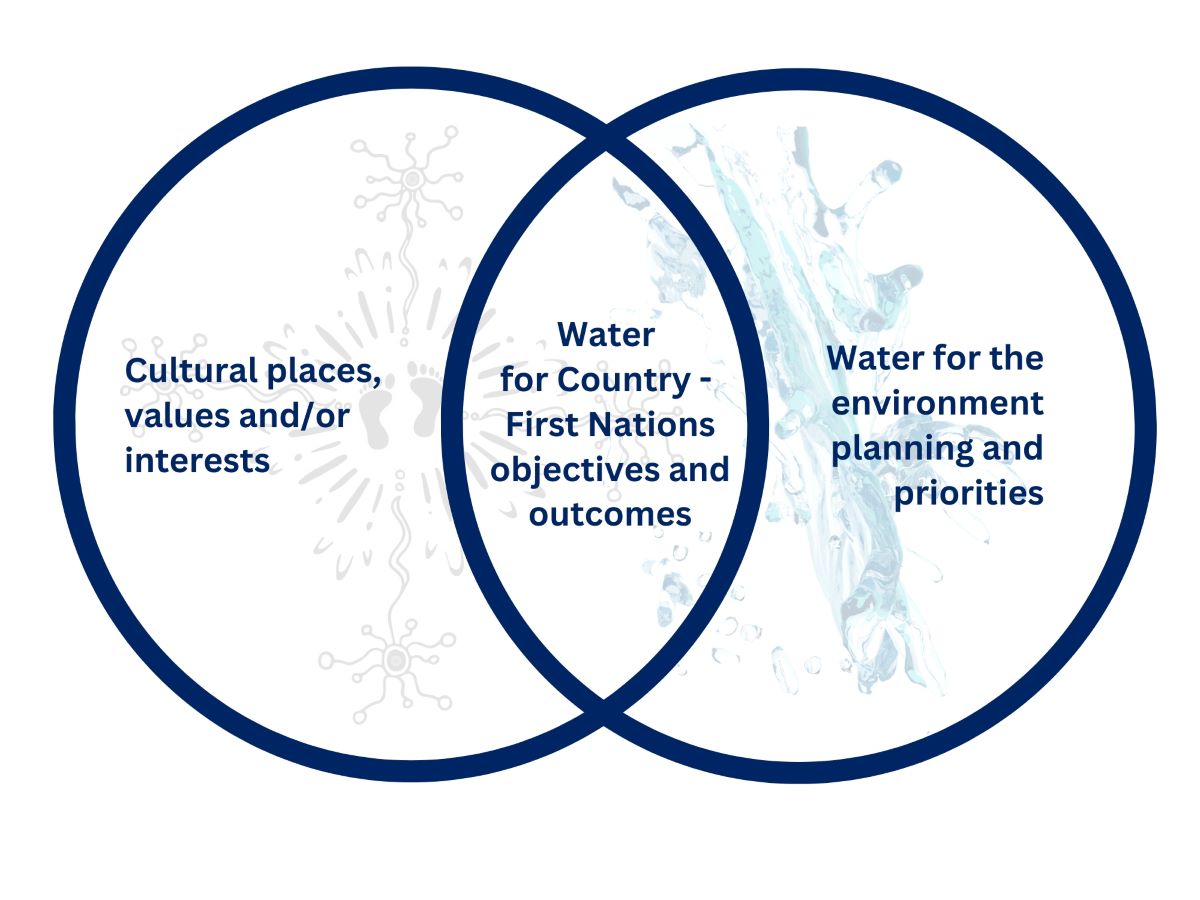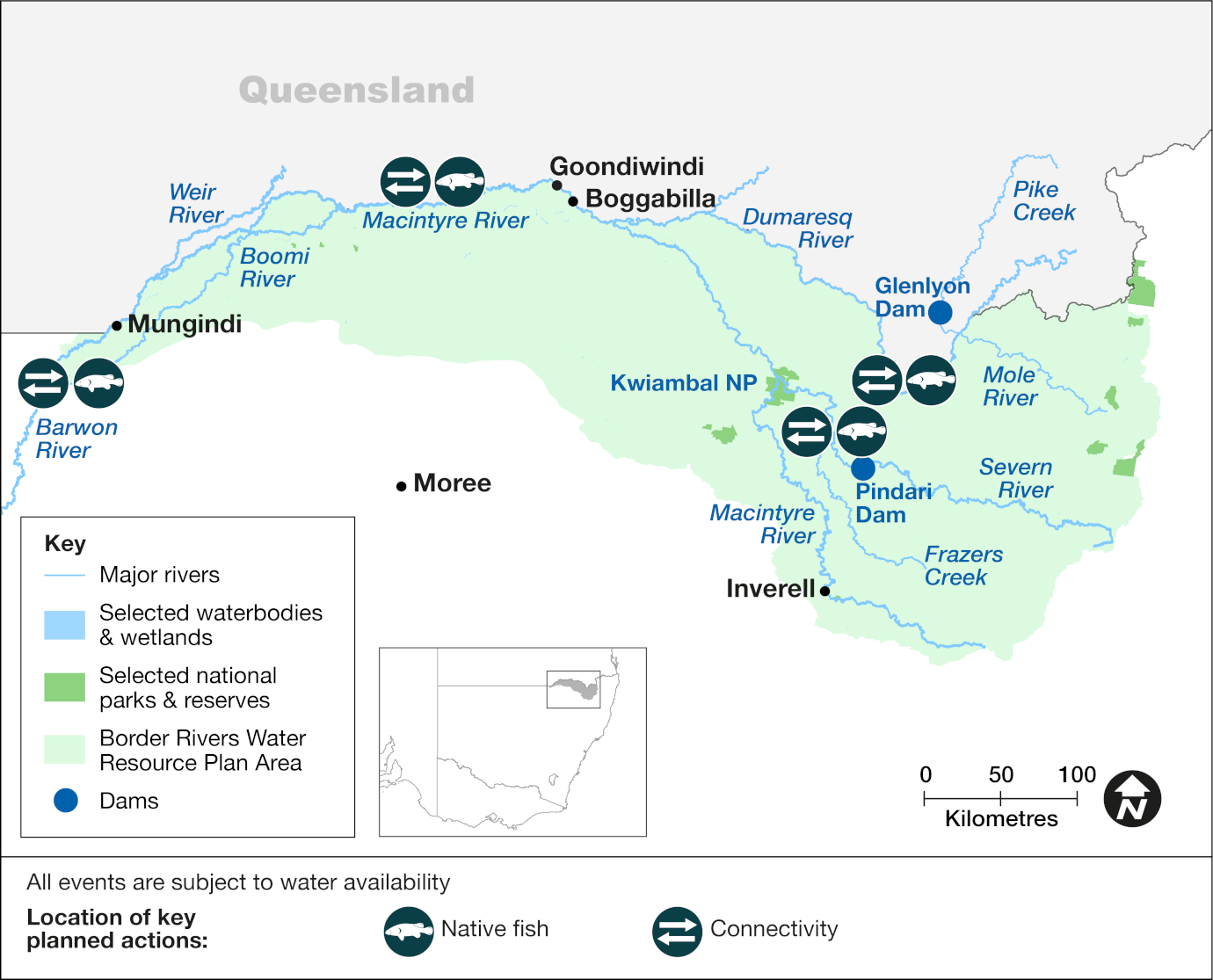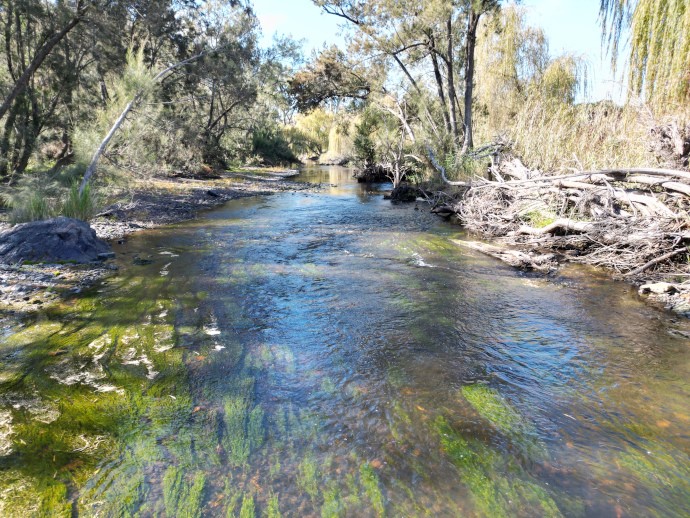Water that is allocated and managed specifically to improve the health of rivers, wetlands and floodplains is known as water for the environment.
Our environmental water management teams work with local communities, Aboriginal representatives, partner agencies, and other stakeholders to develop detailed annual plans for the use of water for the environment in each catchment, including how its use is prioritised.
Water for rivers and wetlands
Following wet years in 2021 and 2022, in 2023–24 the Border Rivers catchment experienced moderate rainfall and river flows. Moderate flows and variable natural tributary contributions were observed downstream of the Pindari and Glenlyon dams during spring through to summer.
Flow records show that despite recent wet years, environmental water requirement targets haven’t been met due to previous dry years. For example, a small fresh occurred in 2023–24 in the Barwon River at Mungindi and the Severn River at Ashford; however, the annual requirements have not been met over the last 10 years because small freshes were absent in previous drought years .
Similarly, large freshes have not occurred often enough to optimise fish outcomes.
With healthy account balances as of 1 July 2024, the Department of Climate Change, Energy, the Environment and Water (the department) may set aside water for use in future years to support the longer-term resilience of the catchment through drier times.
Partnering with Aboriginal peoples

Environmental water managers have been working to support Aboriginal people’s priorities in water management.
Water for Country is environmental water use planned by the department and Aboriginal people to achieve shared benefits for the environment and cultural places, values and/or interests.
Water managers aim to develop relationships with Traditional Owners and representatives throughout the Border Rivers catchment to:
- discuss, where willing, important water-dependent cultural sites that may benefit from environmental water
- discuss the best use of environmental water from the Pindari Stimulus Flow account
- commence work on the review and update of the Border Rivers Long-Term Water Plan.
Weather and water forecast
As of June 2024, the El Niño–Southern Oscillation outlook is neutral. That is, neither La Niña nor El Niño conditions are favoured as oceanic and atmospheric indicators have returned to neutral levels. International climate models suggest neutral El Niño–Southern Oscillation conditions will persist through the southern winter, but there are some signs that La Niña conditions could form later in the 2024–25 water year. Water managers have prepared watering plans that consider a range of weather and water availability scenarios. This is known as resource availability scenario planning.
Resource availability scenario
This table provides details about how we plan for different resource availability scenarios. Dry to moderate conditions are forecast for the Border Rivers catchment in 2024–25, which means water availability planning will follow the 'dry' and 'moderate' scenarios.
Forecast: Dry to moderate
| Conditions | Main aim | Other aims |
|---|---|---|
| Very dry | Protect | Avoid critical loss Maintain key refuges Avoid catastrophic events |
| Dry | Maintain | Maintain river functioning Maintain key functions of high priority wetlands |
| Moderate | Recover | Improve ecological health and resilience Improve opportunities for plants and animals to breed, move and thrive |
| Wet to very wet | Enhance | Restore key floodplain and wetland linkages Enhance opportunities for plants and animals to breed, move and thrive |
Key planned actions
Native fish
Water managers may use water for the environment to support native fish movement, breeding and recruitment outcomes in the Dumaresq River downstream of Glenlyon Dam and in the Severn and Macintyre rivers downstream of Pindari Dam.
If used, the Pindari Stimulus flow would most likely occur in spring as a small fresh event at Ashford. This would benefit native fish breeding, recruitment and dispersal.
Baseflow events provide fish with an opportunity for movement and population mixing.
Connectivity
Held water for the environment may be used to provide a low connection flow along the Dumaresq and Macintyre–Barwon system to replenish and refresh pools.
If moderate-sized natural events occur, water for the environment may be delivered to extend the duration of these events and the distance this water will reach downstream. Held water for the environment may be released to increase the peak flow rate to inundate higher benches and low anabranches and their connected wetlands.
If larger natural events occur, the use of NSW’s held supplementary and Queensland’s unsupplemented licences can retain a proportion of these flows instream.
Vegetation
The flows delivered under the connectivity and native fish actions will be managed to maximise benefits to riparian and aquatic vegetation.
Map of proposed annual priority targets in the water resource plan area 2024–25

Map of the Border Rivers catchment area showing priority targets for environmental water to be delivered to in 2024-25.
The Department of Climate Change, Energy, the Environment and Water delivers water for the environment where and when it is needed to support the health and resilience of rivers and wetlands. We use the best available science, management expertise and experience to manage water across the landscape. This statement of annual priorities identifies the waterways and wetlands that are likely to receive water.
Our decision-making process considers:
- expected availability of water in the coming year
- conditions of the previous year
- current health of the plants and animals in these ecosystems.
Water for the environment delivers benefits for communities, rivers, wetlands and wildlife across New South Wales.
Healthy, connected rivers and floodplains are a focus for tourism, fishing, recreation and relaxation. Rivers carry water to our homes, schools, farms and businesses, and along the way, support countless species including native fish, waterbirds, frogs, plants and more.
Rivers and wetlands have great cultural and spiritual significance for Aboriginal people.
Water for the environment is a critical tool to maintain and enhance the rivers, wetlands and wildlife we all love.
Working with communities
Local communities are at the heart of everything we do.
We involve the broader community by holding site tours and forums, and online and in-person events.
In catchments that have community-based environmental water advisory groups, our local water management teams consult with them regularly.
Environmental water advisory group members include local landholders, recreational fishers, Aboriginal people and local government representatives. Their advice helps to inform the decisions made by our local environmental water management teams.
The Border Rivers catchment doesn't currently have an environmental water advisory group, but the Department of Climate Change, Energy, the Environment and Water is in the process of developing one.
Planned environmental water
| Source | Maximum volume available (gigalitres) | Volume expected 1 July under current conditions (gigalitres) |
|---|---|---|
| Discretionary Planned Environmental – Pindari Stimulus Flow | 8.0 | 8.0 |
Water licenced to the Commonwealth
| Source | Maximum volume available (gigalitres) | Volume expected 1 July under current conditions (gigalitres) |
|---|---|---|
| General security | 2.806 | 2.806 |
| Supplementary | 1.437 | Event dependent |
| Medium (Qld) | 15.54 | 15.54 |
| Unsupplemented (Qld) | 19.986 | Event dependent |
Notes: Qld = Queensland. This is an indicative summary of expected volumes to be available. For further detail and information on available volumes, contact the region via the Department of Climate Change, Energy, the Environment and Water on 1300 361 967.
1 gigalitre = 1000 megalitres; 2.5 megalitre = 1 Olympic swimming pool.
Water for the environment has been delivering outcomes for rivers, wetlands and wildlife for 30 years.
We deliver flows that:
- trigger native fish to breed and move
- support waterbirds to nest and feed
- connect rivers and floodplains
- water forests and floodplains
- allow plants to grow, flower and set seed
- create refuge during droughts
- enhance outcomes during wetter times
- release vital nutrients from the floodplain floor that underpin the aquatic food web.
It's habitat restoration on a landscape scale.

Macrophyte beds in Severn River near Ashford in the Border Rivers catchment
More information on planned and past watering events
- Annual environmental water priorities in the Border Rivers catchment 2023–24
- Annual environmental water priorities in the Border Rivers catchment 2022–23
- Border Rivers – Water for the environment: Annual priorities 2021–22
- A year in the Border Rivers catchment: 2022–23
- A year in the Border Rivers catchment: 2021–22
- A year in the Border Rivers catchment: 2020–21